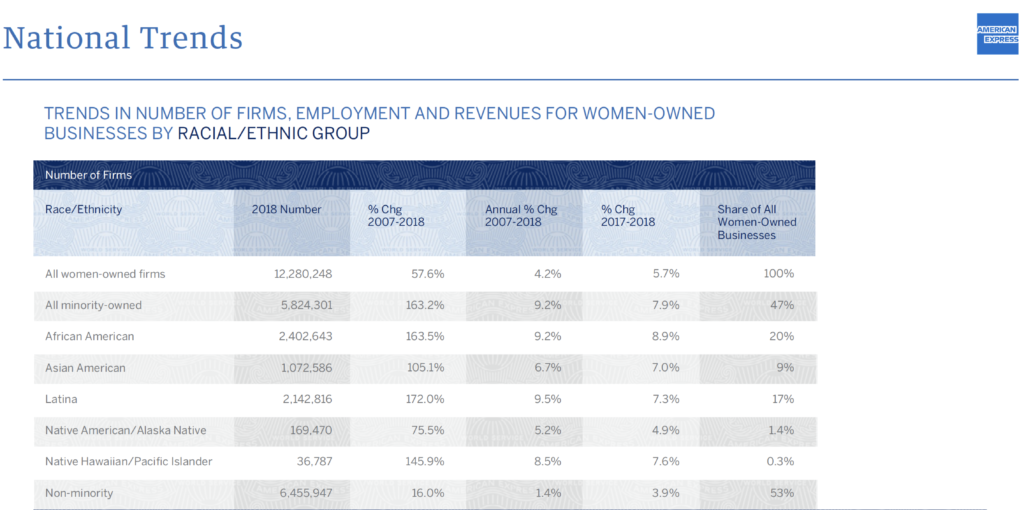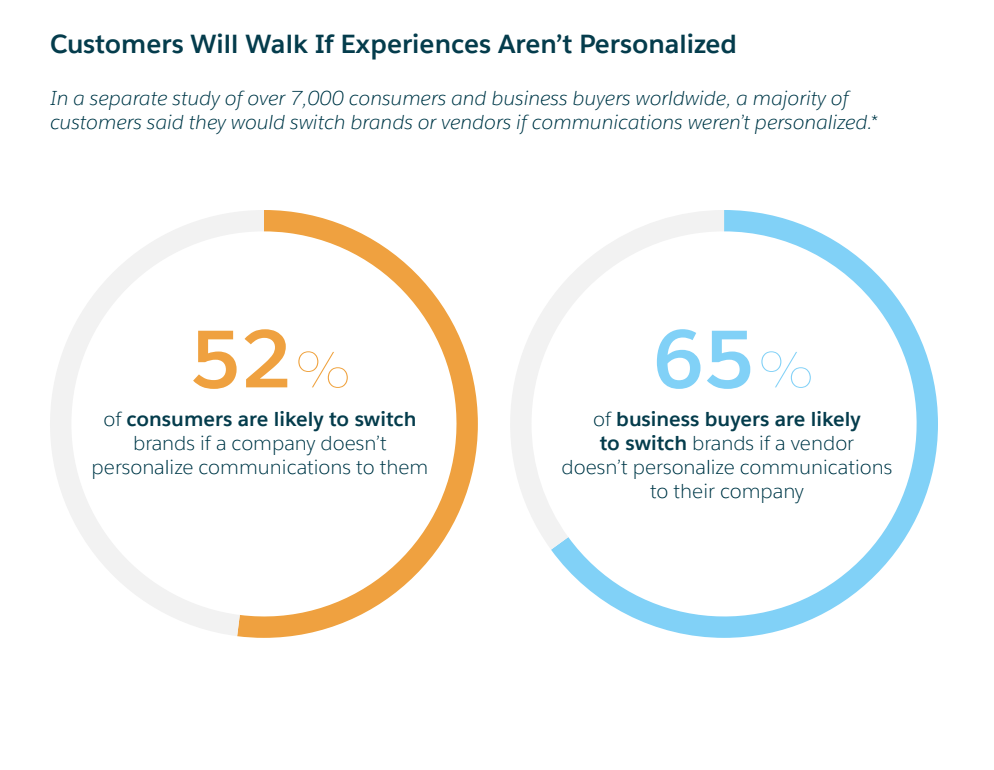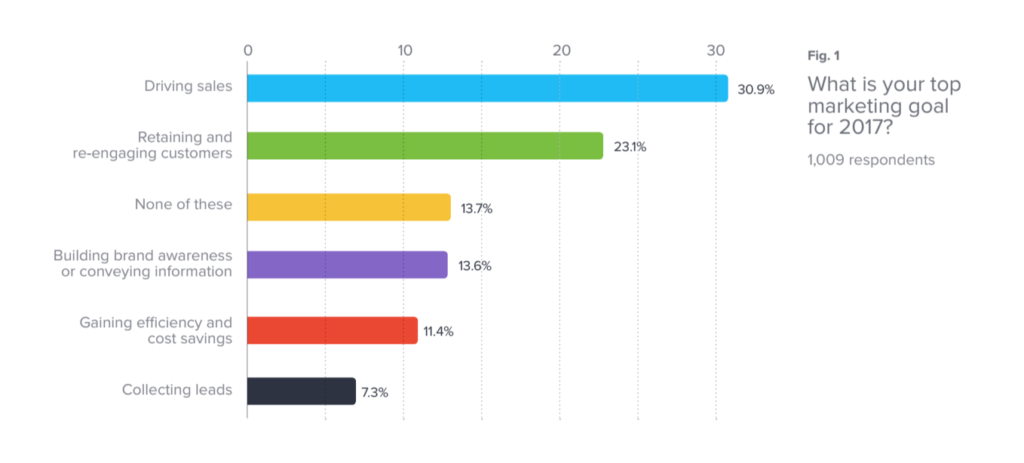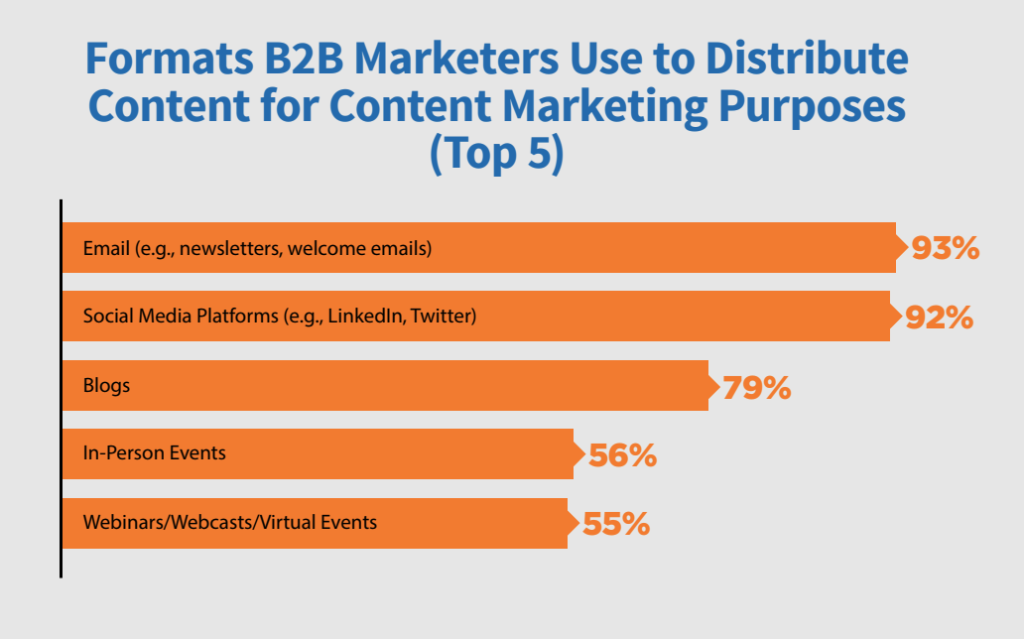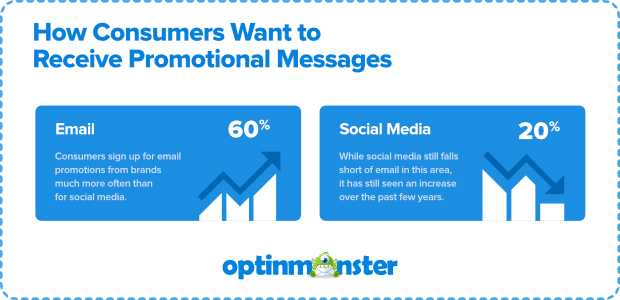Selling to small businesses is an entirely different animal…
It requires a different approach than marketing to consumers, mid-sized companies, or enterprise organizations.
But first, why should you care about selling to small businesses?
According to the Small Business Administration (SBA), there are 33.1 million small businesses in the United States. Meanwhile, the U.S. Chamber of Commerce found that 66% of small business owners have a positive outlook on their companies and the economy while 29% plan to hire more workers in 2019.
In addition, 78% of respondents indicated that their businesses are currently profitable in a recent survey.
The positive trend means there’s significant revenue potential selling to small businesses, including the 8 million minority-owned and 12.3 million women-owned businesses that present additional opportunities.
In fact, women-owned businesses have generated $3.1 trillion in revenue in the past year. There are 5,824,300 women-of-color-owned businesses, employing 2,230,600 people and generating $386.6 billion in revenues in 2018.
Although these numbers indicate that small business owners have an optimistic outlook and are likely to invest more in their companies, they tend to be conservative with their spending.
That’s not surprising when you put yourself in their shoes.
Small businesses don’t have any money to waste and often have tight profit margins. Unlike larger businesses, one misstep can lead to a significant financial impact that can take months or years to recover from.
Unlike corporate C-suite executives, small business owners have to worry about keeping the lights on. They’re under tremendous pressure to make the right purchasing decision every single time.
And yet, they can’t afford to stay still either. If they don’t make the right choice and take the appropriate actions, they could easily lag behind their competitors and go out of business.
Small business owners face very different challenges and therefore, make decisions differently than your average consumer. They’re juggling many roles in their business and are always strapped for time. Unlike selling to larger companies, you need a streamlined approach that’s smarter and simpler to engage this market.
If you haven’t run a small business or don’t regularly talk to small business owners, it’s not easy to navigate the marketing and sales process.
So, how do you effectively market to small business owners?
You need to understand how they make purchasing decisions and how their business operations differ from larger organizations. This will help you create relevant marketing campaigns, position your products or services to speak to their unique challenges, and set up your sales process to meet their needs.
In this article, you’ll learn how to:
- Align with small business owners’ mindset for an engaging conversation.
- Appeal to small business owners by speaking their language.
- Position your products and services to solve small business challenges.
- Implement compelling marketing campaigns to attract and convert small business owners.
Ready for a smarter, simpler approach for selling to small businesses? Here’s how to create a win-win situation for both your small business customers and yourself:
1. Understand the Small Business Owner Mindset
Before you create any marketing collateral, you need to understand small business owners’ unique mindset. They’re a unique group of dedicated professionals who are driven to succeed.
For example, 26% started a business because they wanted to be their own boss while 23% did so to pursue their passion.
Their thoughts, challenges, habits, and priorities are very different from salaried decision-makers or high-level executives at larger organizations. For example, a small business owner’s income is not always unpredictable and this definitely influences how they make buying decisions.
Small business owners are:
- Budget-sensitive: most small business owners don’t have a defined budget to buy needed products and services. More entrepreneurs than you would think are living from paycheck to paycheck.
- Concerned about immediate ROI: they seek immediate results for their investments and they tend to focus on today’s action.
- Hesitant to make big purchases: they want to stretch their hard-earned dollars as far as possible, so they are generally cautious with their spending.
Due to revenue fluctuations, small business owners are price-sensitive, want their investments to generate immediate cash flow, and tend to be cautious when making large purchases. While they have a mindset of a risk-taker, they’re also risk-averse.
They’re a tough sell… but not an impossible one.
Small Business Owners Are Willing To Invest
Just because small business owners want to make the most of their hard-earn money doesn’t mean they don’t understand the importance of partnering with trustworthy vendors that can help them meet their goals.
They value trust and relationships when doing business and they’re willing to invest in products and services that can help them succeed.
For example, 80% of small business owners recognized the importance of using technology to help them future-proof their businesses, increase their marketing ROI, and streamline workflow. As such, 13% plan to invest more in their CRM systems in 2019.
Value is the keyword when selling to small business owners.
They understand that in order to become more profitable, they need products and services that can help them:
- Improve operational efficiency
- Increase revenue
- Generate more leads
- Strengthen their relationships with prospects and customers
Therefore, the key to successfully selling to small business owners is to build trust and a genuine relationship while demonstrating that your offerings can help them generate immediate ROI, create a positive impact on their bottom line, and make their lives easier.
2. Speak the Language Of Small Business Owners
Since small business owners have a unique mindset, you have to speak to their language in order to develop rapport and address their specific challenges.
One-size-fits-all marketing approach won’t be effective if you want to stand out from your competition and attract more buyers.
In fact, 53% of customers now expect to get personalized offers and 62% think companies should anticipate their needs during the various stages of the customer journey — and it’s no different for small business owners. Small business owners are people first.
As with any sales conversation, you need to adapt to the environment and the psychology of your prospects by connecting with them on their terms, empathizing with their unique challenges, understanding their specific business goals, and communicating in a way that resonates with them.
Keep in mind that small business owners tend to have conservative spending habits and they’re often skeptical of salespeople from large corporations. When you’re marketing to them, you will need to overcome the barriers they have in place.
Invest the time to gain their trust, build relationships, and cultivate loyalty by speaking their language, addressing their challenges, and position yourself as their ally.
Top Mistakes In Communicating With Small Business Owners
Here are the most common mistakes many larger businesses make when communicating with small business owners:
- Referring to your prospects as an acronym
Nobody wants to be referred to as a faceless string of alphabets and it’s no different for small business owners. They consider themselves as entrepreneurs and want to be treated as unique individuals.
It doesn’t matter whether they’re a wellness coach or an interior designer. These professionals worked hard to get to this point of self-sufficiency while swimming against the current of dependable paychecks, generous healthcare coverage, and cushy corporate benefits. They want the straight talk.
Avoid using jargon like SMBs (Small and Mid-Sized Businesses) or WBEs (Woman-Owned Businesses) — the acronyms don’t show your audience that you respect them as individuals.
- Addressing your prospects with a “group mentality”
Your prospects are individuals and they want to be communicated to as such. In fact, they’re probably the individuals who hold 100% of the purchasing power of their businesses!
Generic communications will be swiftly ignored. In order to capture your prospects’ attention, you need to demonstrate that you’re vested in helping them meet their goals through a thoughtful messaging strategy.
For example, the last thing a real estate agent wants is to be sold to. They know that game well, and you will lose their trust with impersonal conversations. A good agent is successful at selling homes because they’re savvy at relationship-building. Take cues from savvy networkers and tailor your message to each individual.
“Every small business will give you an entrepreneurial way of looking at things. The small-business attitude is you always find a way to make it work.” – Hamdi Ulukaya, Founder of Chobani Yogurt
- Presenting a laundry list of jargon-filled features
Small business owners are often the “Chief Everything Officer” who have a lot to juggle. They don’t have the time and energy to decipher the jargon in your marketing copy or to wade through a laundry list of product features.
Instead, make sure your messaging gets straight to the point. Tell them how your product or service will help them with these most common objectives: win new customers, lower expenses, and save time.
Speak clearly and directly. Skip the fancy terminologies in favor of simple language that small business owners use every day. Instead of a detailed list of features, focus on communicating the benefits. Tell them what specifically will shift in their business if they invest in your product.
Consider a small financial services firm that operates on a tight budget. If you’re selling the owner HR software, you need to focus on telling the story of efficiency. Show the decision-maker that you understand his pain and how your product will solve his challenges.
A brief, educational presentation that positions your product or service as the answer to your prospects’ problems will go a long way. Respect their time and attention, and be the resource they have been searching for.
Position yourself as a partner, not as a vendor.
3. Focus On Solving Specific Problems
If you can solve a small business owner’s problems, you’ll be on your way to meeting your own marketing, sales and product adoption goals.
Demonstrating how your product or service solves specific pain points is the rule #1 in a positioning strategy that drives an effective sales process, which is built upon your understanding of the small business owners’ mindset and language.
Not a minute goes by when small business owners aren’t facing multiple challenges, including the need for more cash flow and customers, or having a slew of ideas without the means to implement them.
In a recent survey of U.S. small business owners, 22% indicated that lack of time and resources is their biggest challenge while gaining and keeping clients remains the top goal in 2019 — 28% respondents identified driving sales as their No. 1 priority and 18% said they needed to retain more customers.
The key to successfully selling to small business owners is to demonstrate that your offerings are the missing links to solving their challenges and meeting their business objectives.
Don’t try to convince them how great your product is. Instead, educate and guide them to recognize how your offerings can solve their problems and help them reach their goals while acknowledging their cautious approach to business spending.
5 Proven Marketing Methods To Overcome Risk Aversion
Your sales and marketing process should be designed to reassure prospects that your product or service is worth their investment:
- Demonstrate undeniable growth – focus on immediate “pain relief” while revealing how your product or service will serve them in the long run.
- Speak to specific challenges – show how your product saves small business owners time and money while increasing their revenue.
- Stop selling – add value by positioning yourself as an ally who can help them reach their goals and grow their businesses.
- Stay in touch beyond the sale – offer ongoing support and build relationships through consistent communications that add value.
- Build trust with education and training – educate prospective customers on current technologies, techniques, and success paths to help them meet their goals.
Every business is unique and so are the pain points each business owner experience on a daily basis. Do your homework and identify opportunities where your offering can improve a prospect’s life so you can position your product or service accordingly to increase conversion.
“For small business people, less paperwork means higher profits, boosted sales, and more time with the family.” – Tony Abbott
4. Implement an Effective Small Business Marketing Plan
Content marketing is one of the most cost-effective marketing strategies to help you get found by and build trust with small business owners. In fact, 96% of most successful content marketers say audiences view their company as a trusted resource.
This proven strategy helps deliver relevant messaging, engage prospects, and systematically lead them to the point of conversion. The goal is to educate, not to sell. No matter what you’re offering, there are numerous ways to accomplish this without alienating potential customers.
Content Marketing Institute’s latest research found that email marketing, educational content, and in-person events to be the most popular ways to nurture relationships with an audience.
While blogging and social media are common distribution channels for content marketing, they may not work as well for busy small business owners… who really don’t have time to drink their morning coffee while leisurely reading blogs and then hang out on Twitter!
The whole point of marketing is to reach people, right? So when you’re trying to reach small business owners, the three most effective content marketing campaigns are live events, webinars, and email newsletters.
“The number one thing small business needs is to get more customers. Spend more time serving existing customers and getting new ones. The challenge for small business is knowing where customers are and reaching them effectively.” – Brad D. Smith
How To Use Content Marketing To Sell To Small Business Owners
Small business sales are driven by relationships, so you have to build trust through communication channels that work for the decision-maker you’re aiming to reach:
Live Events
Getting face time with a small business owner can be tough and in-person events offer a great chance to connect with prospects and build deeper connections with them.
Events (like this event we produced for Small Business Week San Francisco) help cultivate immediate trust. They allow customers the opportunity to ask questions and learn about your product. People also like networking with other small business owners in a group setting over food and drinks.
A grand keynote speech in a giant conference room isn’t the only way to run a live event. Instead, consider hosting a networking breakfast or a lunch-and-learn in a more intimate space that invites meaningful conversations.
Here’s an example of how Stripe incorporated a bit of small business market research into one of their employee events:
Webinars
A live webinar offers many benefits as a live event does while allowing you to reach a larger web-based audience. It gives you the opportunity to educate small business owners about your products and services at scale within a short time.
These online events are very effective in delivering an engaging experience. Over the past several years, the average webinar viewing time is close to an hour.
It’s important to follow a proven strategy when orchestrating your webinars. The right approach will successfully engage your prospects, build relationships, and speed up your sales cycle.
Design your webinars so that the content will directly benefit time-starved small business owners on the other side of the screen. A how-to training session is an ideal format for building trust with entrepreneurs struggling with overwhelm and limited resources.
Incorporating a Q&A section also helps engage the audience and give you the opportunity to address questions, objections, and misconceptions about your product, service, or brand.
Based on the interactions, you can identify prospects that are most engaged with your message so you can nudge them to the next step in your sales process. These leads might even be ready to become your customers by the time the webinar is over!
Email Newsletters
Email isn’t going anywhere. Email marketing can generate an astounding 3,800% ROI and it’s used by 93% of B2B marketers for content distribution.
In a survey, 59% of respondents said marketing emails influence their purchase decisions while 80% of marketers found that email marketing helps them increase customer retention.
In other words, email newsletters work. They give you a consistent means to connect with prospects and customers.
However, most small business owners’ inboxes are overflowing. You need a well-designed strategy to guide your email marketing campaigns so you can create content relevant content, attention-grabbing subject lines, and stand out from your competition.
Design and write your email newsletters in a style that speaks to your target market, addressing their day-to-day pain points and big-picture aspirations. E.g., some brands do well with magazine-style email newsletters while others experience high conversions using single or hybrid-style designs.
To find out exactly what works for your audience, conduct A/B testing and analyze the metrics to fine-tune your strategy.
“Email newsletters will re-emerge as an important nurturing vehicle.” – Ann Handley, Chief Content Officer, MarketingProfs
Conclusion
Now you’re armed and ready with a smarter, simpler approach to selling to small businesses and you have “walked around” in the shoes of a small business owner.
You know exactly where your prospects’ pain points are and how your product or service can help them achieve their business objectives.
Solving small business challenges isn’t easy but it’s rewarding.
You need equal parts of empathy and strategy, as well as the willingness to explore a new approach in your sales process:
You aren’t a salesperson but a resource; you aren’t closing a sale but delivering value to the customers; you aren’t a vendor but a partner.
Small business owners will appreciate your fresh perspective amidst the noise and turn to you for guidance with their challenges and goals. You’ll achieve success when you implement a strategy built upon relationships and trust.
Ready to sell smarter? Download our insights paper How to Successfully Sell to Small Businesses.

